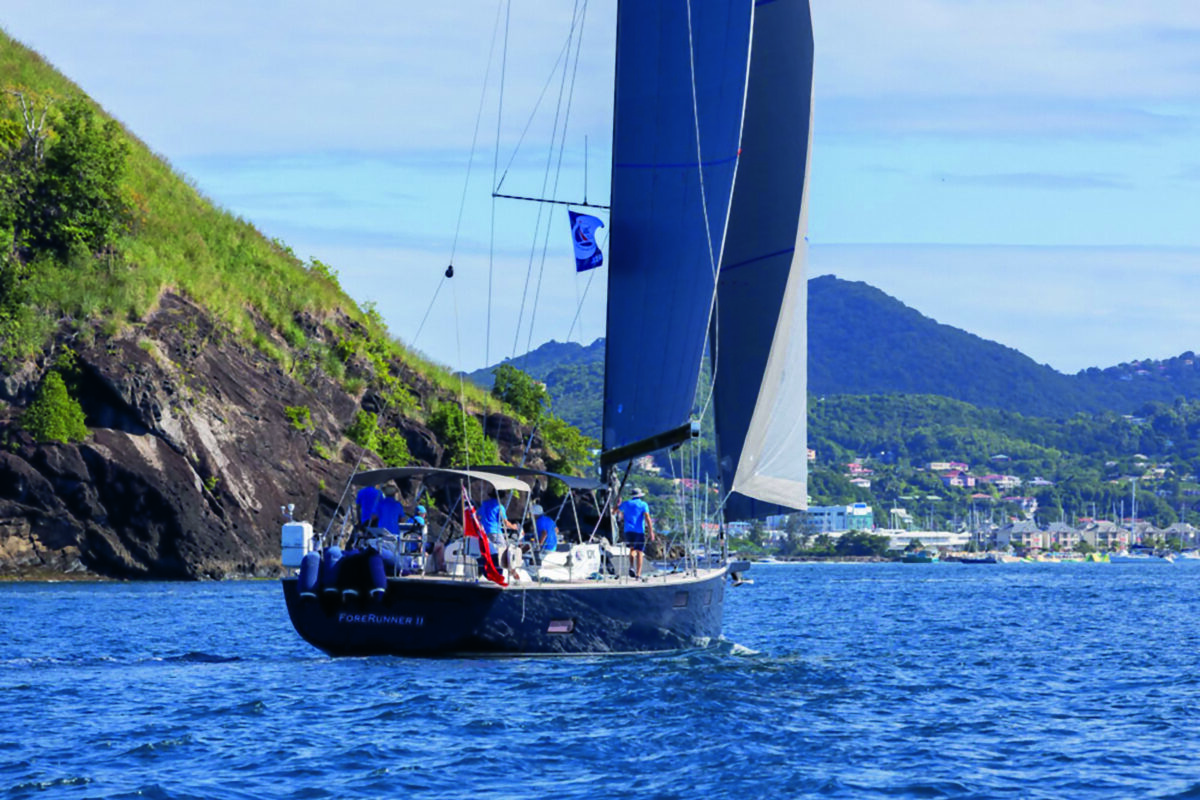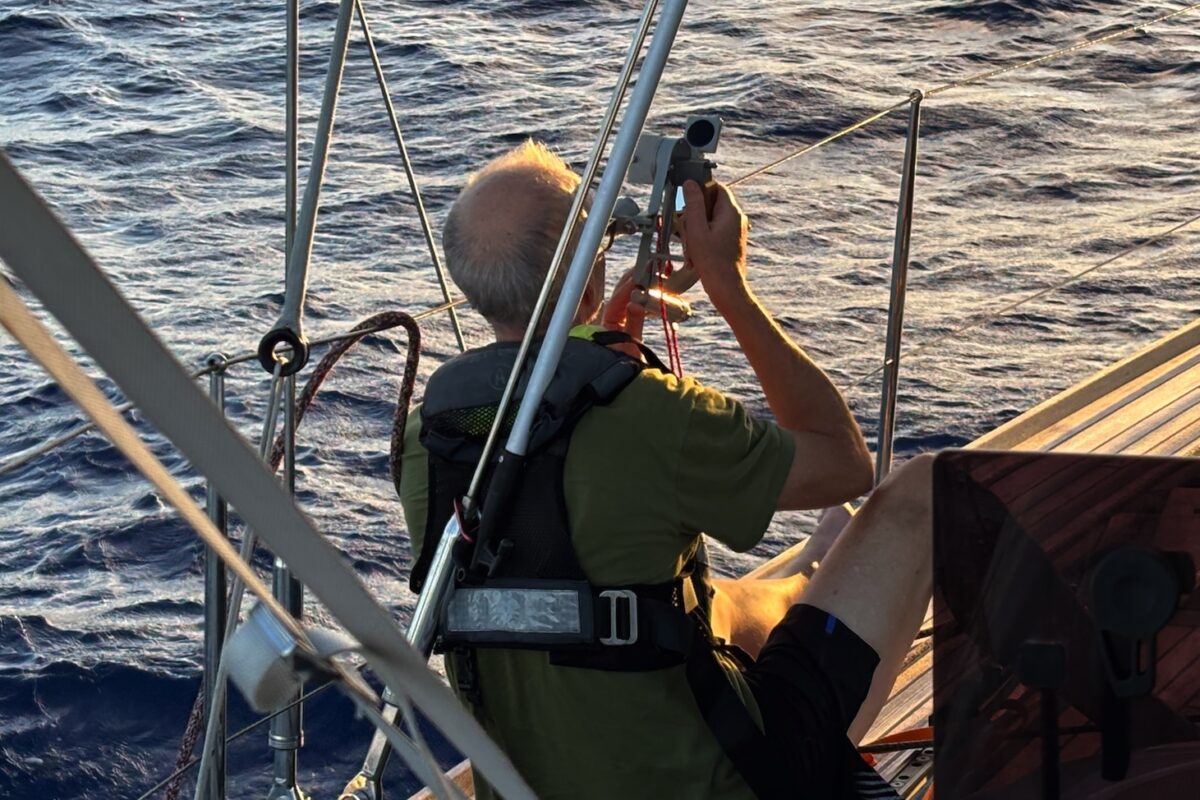Fourteen years into ownership of a first yacht and wanting more space for two couples, Robert began a long and well-considered search for a new yacht. The goal was more space and also a brighter, lighter interior with a good outlook for navigation and, equally, easier monitoring of sailing operations from down below.
The quest led to the commissioning of new-build Contest 55CS ForeRunner II and desires for more high-latitude sailing, and the ARC as the starter of a far reaching North Atlantic circuit.
Robert grew up sailing dinghies on Britain’s east coast and later crewing friends’ yachts.
Then came as for so many a long step away from the sport. In Robert’s case a move to the USA for a PhD and new life, leading two decades later to a return to home shores with a grown family of five, and an evident will to go sailing again.
“It was 2004 and a sudden big step to have a yacht of our own!” Robert says of his original ForeRunner, a Sweden Yachts 42. “It was well built and sailed well, and we had enjoyed our sailing of her, including the Stockholm archipelago, and later down to Galicia in Spain, the furthest south we had been. But then about six years ago, I started to look for something bigger.”
Prompting that decision, Robert had wanted generally more storage, disliked the idea of davits, and had tired of inflating and deflating the dinghy on his Sweden Yachts 42, which had led to the tender being hardly used. “I was looking around the brands and originally for a 50ft boat, but by the time I’d added on a dinghy garage I ended up at 55ft,” he laughs.
“The real drive, though, was to have more space, to have a boat for two couples,” Robert says. “The old boat had two aft cabins with not huge amounts of headroom, and the bed in the forecabin was along the side of the boat, so only a small double. Secondly, my wife Edie really wanted more light and visibility below; she didn’t like that sense of going down into a bunker.
“Even though our Sweden Yachts had nice wood and fabrics, it still felt a little like a cave, you couldn’t see out when down below. I also wanted more outdoor living space, generally more comfortable space to live in on the boat.”
Wanting good high quality again, Robert had started his search among his already known Scandinavian brands, visiting each yard to look deeper and deeper, before tipping also into France and the UK, and then coming to rest with Contest in the Netherlands.
Observations along the way that informed decisions included a wide variety of concerns: helm stations set too far aft and apart on decks overly wide for security and safe movement; cockpits too confining or abruptly shaped and coamings too low for comfort; to methods of reefing offered or not; and then of course interior layouts, floor plans, standing height, space, and degrees of outlook and natural light and brightness.
Decisions in pandemic days
The visits and reasoning all led ultimately to the Contest 55CS. “I liked the family-run Contest yard,” explains Robert, “and saw the first-built 55CS in February 2020 at boot Düsseldorf. My wife and friends all liked the interior design and layout, and with everything lining up I ordered the yacht in that March.”

So, the search that began in 2018 was settled in 2020, just as the pandemic began to impact. An interesting and potentially difficult time to commission a new build. “It was frustrating not being able to see the other boats to help us with our own specifying, or to visit during the build,” says Robert, and some of the changes along the way did delay completion, but with good reason and a satisfactory outcome.
In-mast reefing had always been a must-have, which at this size, without going to custom build, meant aluminium for the spars. Then in December 2020, the maker Seldén announced the introduction of the first suitable carbon- in-mast system. The benefits were clear. A stiffer, lighter rig improving performance both ends of the wind-scale and easing the ride through waves as well as wind.
The switch was made but delivery of the rig was nine months away in September 2021.
Unintended consequences do tend to attach themselves to such delays, and with Robert and Edie contracting the services of Contest’s interior design partners Wetzels Brown to help with styling and detailing, the mood boards had time and scope to run to Version 6!
“It was so hard during Covid to go and see things and to pull in samples and shape ideas,” explains Robert, “so, we really needed someone to help us. We did this on Zoom as well and it all worked out in the end.”
The eventual theme was light oak for the main joinery, light grey floors for contrast, and a blend of orange, russet and blues for the cabin dressing. That in-mast reefing had also been so important to Robert for reasons he explains, “With just the two of us on the boat, or if I’m out by myself on watch at night, I want to be able to furl the sail quickly and simply which you can immediately with in-mast furling, whereas slab reefing or in-boom requires a couple of people at least.”
Ease of control was fundamental in Robert’s selection (and de-selection) process, “I like the helming position on the Contest, it being a little bit further back behind the mainsail, and also with the main winch between the helm stations this is easily reached.
“Together this means you can still see what’s going on with the sail, all at once when trimming. On other-styled boats, I really didn’t like cockpits being pushed so far aft, or a centre cockpit having the main winch behind the helming position making it really awkward to watch what’s going on with the winch.”
With hydraulic headsail furling and electric winches, Robert chose to upgrade the spec for his North Sails wardrobe, although staying with the standard pairing of vertically battened main and 106 per cent jib, and including a Code 0 plus a Parasailor.
“That’s for the ARC and to reduce chafing,” Robert says of the Parasailor. “There are two options, 270 and 250m2 and I went for the more conservative choice, as it’s easier to handle and keep up a little longer.”
Fluid plans
With ForeRunner II first launched in October 2021, Robert sailed the IJsselmeer for a brief week of windy weather getting to grips with the ways and working of the family’s new yacht before tucking her away for the winter. Then in May 2022 it was time to be away to Norway.
“Taking a month, we went just up to Bergen because I didn’t want to push myself this first year. We had a day or two of heavy weather off the Dutch coast and stopped in East Friesland, then ended up going all the way up to Thyborøn in north-west Denmark because that’s where the wind was taking us!” he laughs. “That all worked out fine and then it was over to Farsund in Norway from where we worked our way up to Stavanger and Bergen. We sailed the Bergen area for a week, going out to some of the islands and the little anchorages which were very nice.”

Leaving the yacht there for a return visit later in the season, Robert says having seen the beauty, and sampled one fjord on this trip, he wanted to go back and further north, “Hopefully to Lofoten,” he said at that time, acknowledging, “that’s one plan but things are rather fluid. I do want to do the ARC, and that would be in 2023 or 24, and then in a transatlantic circuit we want to go up the east coast of the US. We have family with a beach house in Connecticut so it would be nice to visit there in ForeRunner II.
“For the circuit we’re toying with the idea of Nova Scotia, perhaps, and taking the further northerly route back. Iceland then to the Faroes and Norway are among the options. That’s the kind of thinking. We haven’t figured it out yet.”
Well, a big part of that has come to be, Robert sailed to Norway again in 2023, before turning attention southwards last year, sailing France, Portugal and Spain to Mallorca, from where in September ForeRunner IIset off for the start of the 2024 ARC from Las Palmas, Gran Canaria, via Gibraltar and the wee small island of Porto Santo, northeast of Madeira.
Reasoned thinking
Robert’s ARC was still being sailed at this time of writing, with just 400 miles to go before landing in St Lucia, after a crossing made at fair pace, with a crew of six aboard enjoying the comforts of Contest that Robert described before his true Odyssey began.

“The sailing is really good, and the boat, too, looks really good. Everyone looks. I really like the airiness in the saloon, that’s fantastic. With the coachroof windows I can pretty much see all the way around, and the rig and sail trim, too, from below. I really like that. The master cabin, and its height, is fantastic, and the forward guest cabin is really nice, everyone likes the heads, the shower, the detailing. The galley is good, and the espresso machine especially so.”
Robert had also opted for an induction cooker, to avoid LPG (gas) on board, and the Quooker tap system for on-demand boiling water. A great safety feature, he says, and truly handy for hot drink or soup preparation on watch and underway. And for that off- and on-watch monitoring Robert sought, he had specified a multi-function display by his bedside in the master suite further satisfying that stated need to ‘feel the boat below decks’. “I listen to the boat, I can hear the boat, know what the wind’s doing and see what’s going on, so I’m not worried. I wanted a boat that could deal with the Med, the Caribbean and more northerly conditions.”
Docking in St Lucia after the three summers’ high adventure and now a transatlantic, and with all this thinking now truly tried and tested, maybe the ForeRunner II name could equally be Forethought Too.